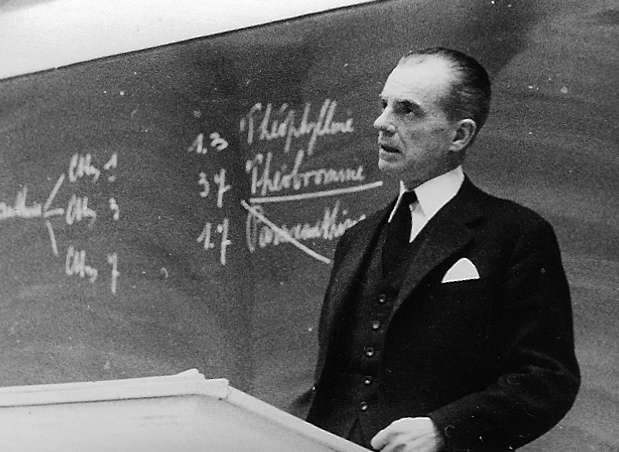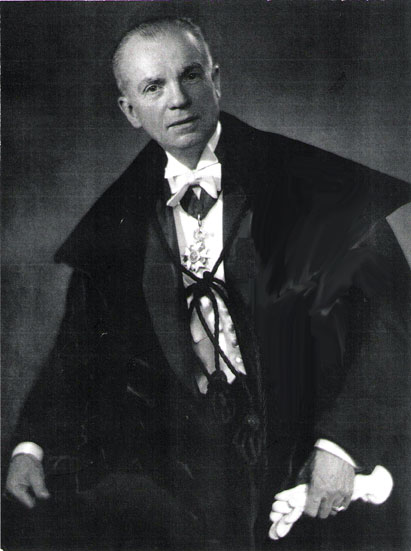Mission of the Simonart Foundation
Encourage research in biomedical science that can advance clinical pharmacology among the present and former students of the Université Catholique de Louvain and the Katholieke Universiteit Leuven.
The Foundation grants a substantial Prize to a young researcher every 3 years.
The Founder
André Simonart was born in Louvain in 1903. Being the son and grandson of doctors, he naturally studied medicine. In 1926, two years before graduating as a Doctor of Medicine from Université de Louvain with the highest honours, André Simonart published several articles with Professor Manille Ide. These early scientific activities earned him the University Competition Prize, the Travel Scholarship Competition Prize and the Quinquennial Prize for Therapeutic and Pharmacological Sciences from the Belgian Royal Academy of Medicine.
On completing his studies, he went to live in the United States from 1930-1932 as a Fellow at the University of Pennsylvania, working at the Nelson Richards laboratory. He then became an assistant to professors Gunn and Sherrington at Oxford and worked with Professor Bijlsma in Utrecht. Having acquired this international experience, he returned to Belgium and became Professor of Pharmacodynamics and Therapeutics in 1936.
He was an extraordinary teacher and all of his students remember the brilliant clarity of his lectures, for which the auditoriums were always packed full. His research work focused in particular on the cholinergic system, the metabolism and the action of acetylcholine. At this time, he described the effects of certain medicines acting as cholinergic precursors and studied acetylcholine antagonists, both muscarinic and nicotinic. As Professor Maloteaux stated: “These were the early days of modern pharmacology, which is characterised by an ever more precise understanding of the way in which medicines act on target tissues at a molecular level and how in this way they modify the physiological mechanisms and can be useful in therapeutics.” 1
He left an impressive list of scientific publications (250) and studies (100)2. One of his remarkable scientific contributions is his book “Eléments de Pharmacodynamie et de Thérapeutique” 3 which was used by medical students for some 30 years. Its exceptional didactic value resulted in it being reedited seven times between 1937 and 1967, translated into Dutch and used by several universities.
André Simonart was a correspondent member of the Belgian Royal Academy of Medicine from 1948, and became a full member in 1960. He was also a founder member and chairman of many academic societies, including the Belgian Pharmacotherapy Association, the Belgian Physiology Association, etc. He chaired the Commission of Specialities at the Ministry of Labour and other committees. He was also the Director of the laboratory for experimental therapeutics at the Université de Louvain.
Out of a concern to disseminate the latest developments in therapeutics to practitioners, at a time when ongoing training were rare, he established and edited the “Leuven Geneeskundig Tijdschrift” and also edited the “Revue Médicale de Louvain”.
Professor André Simonart’s life was also marked by suffering. During the Second World War, he was arrested by the Nazis who were occupying Belgium and imprisoned in concentration camps at Breendonk (Belgium) and Buchenwald (Germany). Condemned to hard labour, he helped other prisoners through his medical knowledge. In his eulogy at the Academy of Medicine, Professor Charles Mertens de Wilmars emphasised how much Professor Simonart, like a member of the Resistance, was modest about his heroism, repulsed by vindictiveness and passionate about truth. After the war, the Belgian Parliament created the Breendonk Fort Memorial in order to inform young people. King Baudouin appointed Professor André Simonart as chairman of the Memorial and he was re-elected numerous times. According to his peers, he assumed this function in an exemplary manner for nearly 30 years. When conferred his emeritus title, Professor Lévy also said of Professor Simonart: “To serve one’s country as he did, one has to suffer and to have understood. Out of loyalty to his ideal, he had to face the killers of this idealism. He had to remain clear-sighted, irrespective of the glare by which he was penetrated.” 4
Beyond his public life, Professor André Simonart was also a husband and father to 10 children.
As Charles Mertens de Wilmars states, Professor André Simonart received his emeritus title in 1969 at a memorable academic session, in which the enthusiasm and humour spoke volumes of the admiration and affection in which the man, his work and his life was held, by the whole country. 5
Fascinated by pharmacological research and concerned to continue to encourage the development of pharmacology which was still in its early stages, Professor André Simonart decided to allocate the funds received when he became professor emeritus to the creation of a foundation aimed at encouraging and promoting the pharmacology work undertaken by students at the KU Leuven and the UCLouvain. In his eyes, both faculties were connected, for he taught there in both French and Dutch. He chaired the Foundation until his death in 1992.
Spurred on by his values and passion, his children and grandchildren have taken up the torch. His grand- daughter, Marie-Noelle Simonart, is the current chairman. She is assisted by three other family members, two Professors from the KU Leuven and two Professors from the UCLouvain.
- J.M. Maloteaux. Le Professeur Baron André Simonart : Un pharmacologue et pharmacothérapeute précurseur à l’Université Catholique de Louvain (UCL/KUL). Louvain Médical 2011 ; 130 (1) :41-45
- Ch. Mertens de Wilmars, T. Godfraind. Eloge du professeur André Simonart, membre honoraire régnicole. Bull. Acad.Med.Bel.83-88, 1993
- A. Simonart. Pharmacologie et Thérapeutique. Editions Aercia S.A. Bruxelles & Librairie Maloine S.A. Paris 7ème édition, 1967
- P. Lévy. Allocution du professeur Lévy, vice-président du Mémorial National du Fort de Breendonck, Manifestation d’hommage professeur A. Simonart, Imprimerie Orientaliste, Louvain, 1969, p 29
- Cfr supra note 2



